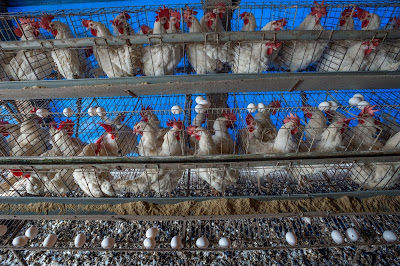FIVE IMPORTANT TIPS TO BOOST EGG PRODUCTION
The top three issues in the layer industry are the disease, sub-optimal management practices, and decreased egg production, all of which can result in lower profits for producers. Preventing these factors will improve egg production and profitability in layer units.
 |
| Egg production |
When chickens are not well fed, egg production will decrease. This is mostly caused by a lack of drinking water and low feed intake levels. Chickens tend to eat less when the feed is not tasty or when they are stressed due to environmental factors, especially when it gets too hot. Therefore, clean drinking water and high-quality feed should be available at all times.
1. Management and lighting
On the management side, as an example, good biosecurity practices and lighting management are important for in-house chickens. When the lights are off, chickens do not eat and this results in low egg production. Lights should be checked regularly so that they do not get dimmer. Exposure to light for less than the minimum time required results in a drop in egg production. On the other hand, when chickens are exposed to too much light, they reach sexual maturity at an early stage and they lay very small eggs.
2. Need for efficiency
Predictions suggest that in 2050, 9 billion people will need to be fed worldwide. Planet Earth is a limited system in terms of natural resources e.g. arable land. So, the challenge is to get more food from the same limited system. The answer is greater efficiency. Efficiency must consider all the stages in the food production chain. Genetic companies are focused on continuously improving laying efficiency. In 1998, a layer was able to lay 310 eggs in 72 weeks. Today, twenty years later, it is 320 eggs in the same period.
3. Layer Feeding Management
The feed is another key factor for layers’ efficiency. Since feed represents between 60% and 70% of the total cost of egg production, a lot of attention is paid to improving feed efficiency. Selected phytogenic feed additives (PFAs) are capable of supporting layer performance in these ways.
4. The power of phytogenics
Phytogenics have traditionally been used as flavors and spices in human nutrition and medicine or even for food preservation. The incredible biodiversity of the plant kingdom provides a large variety of different herbs and spices with an enormous number of active substances exerting different effects in the organism. These effects range from stimulating endogenous enzyme secretion, influencing gut microbiota and enhancing gut protection.
5. Use of Herbs/Plant Compounds
Their mechanism of action depends on the chemical structure of the active substances or constituents. Spices, herbs, essential oils or extracts exert different effects. For example, phenols such as thymol, carvacrol, and eugenol (often derived from thyme, oregano and clove) and their methyl ethers have a very strong antiseptic effect. Species of the families of Apiaceae such as caraway and fennel and Lamiaceae (e.g. rosemary and peppermint) have strong antioxidative properties. Other plant compounds support better digestibility by boosting digestive secretions such as bile, mucus, and saliva, as well as enhancing enzyme activity. Constant and reliable results in animals, however, can only be achieved with a well-defined formulation of a phytogenic blend, including standardized raw material with continuous quality control.
